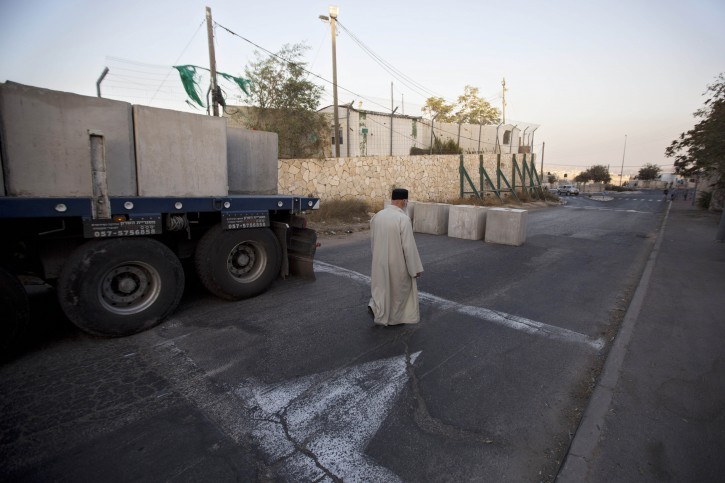
Jerusalem – During a monthlong wave of violence, many of the Palestinian assailants have come from east Jerusalem — the section of the holy city claimed by Israel and the Palestinians.
Israel captured east Jerusalem, home to the Old City and its sensitive holy sites, in the 1967 Mideast war and annexed it to its capital. The annexation has not been recognized internationally, and the Palestinians seek east Jerusalem as the capital of a future state. These conflicting claims lie at the heart of the Israeli-Palestinian conflict.
The unrest — a series of stabbings and shootings by Palestinian assailants across Israel, as well as clashes between Israeli troops and Palestinian protesters in the West Bank and Gaza — was sparked by Palestinian claims that Israel is plotting to take over the city’s most sensitive holy site. The hilltop compound, revered by Jews as the Temple Mount, is today home to the Al-Aqsa Mosque, the third-holiest site in Islam and a key national symbol for the Palestinians.
Israel’s prime minister says there are no plans to change the status quo, dismissing Palestinian claims as incitement. But members of his government have been pushing for Jewish prayer rights at the Muslim-run shrine.
The roots of the unrest run much deeper.
Palestinians, who make up one-third of the city’s population, point to inequities in housing and public services, their vague legal status and Israel’s construction of a separation barrier through their neighborhoods as sources of anger and despair. They say these issues are key reasons why the poverty rate among east Jerusalem’s Arab residents is roughly 70 percent, compared to a national average of roughly 19 percent, according to Israel’s social security agency.
Successive Israeli governments have promised to reduce the gaps, but Palestinian residents say little has changed on the ground.
Here is a look at life in east Jerusalem:
Residency:
The legal status of Palestinians, including those who were born in the city and can trace their family back generations, remains vulnerable.
After 1967, Israel granted residency rights to Palestinians in east Jerusalem and also offered Israeli citizenship — though few Palestinians chose that option at the time because it implied acceptance of Israeli occupation.
Residency entitles Palestinians to Israeli social services and freedom of movement, but without citizenship, they can’t vote in national elections. Most critically, they can lose their residency rights.
Israel’s Interior Ministry says Palestinians lose their Jerusalem residency if they are out of the country for more than seven years, or if they accept residency or citizenship in another country. Jerusalem residents who move to the city’s West Bank suburbs because of east Jerusalem’s housing shortage also risk losing their residency rights.
In addition, Israel has decided to punish attackers by stripping them of residency.
Since 1967, roughly 14,500 Palestinians have lost their residency, including 107 last year, according to Israeli figures.
In recent years, though, a growing number of Jerusalem Palestinians have sought Israeli citizenship because this protects them from being stripped of residency rights.
Separation Barrier:
Israel erected its West Bank separation barrier a decade ago in response to dozens of attacks from Palestinian areas. The tall cement-slab barrier runs through Arab areas of east Jerusalem, separating some 80,000 to 100,000 Palestinian residents from the rest of the city.
Although Palestinians in these neighborhoods do not lose their residency rights, they must cross through checkpoints to enter the city, hindering access to jobs, relatives and public services. For example, neighborhoods behind the barrier lost water services last year for several months.
Palestinians also say the barrier has cut off the West Bank from the heart of east Jerusalem, their traditional commercial and religious center and hoped-for capital.
Schools and municipal services:
While Palestinians make up roughly 37 percent of Jerusalem’s population, their neighborhoods receive less than 15 percent of the municipal budget, according to Ir Amim, an advocacy group that promotes equality in the city. As a result, Arab neighborhoods have potholed streets, overcrowded classrooms and suffer from insufficient public services like water, sewage and garbage collection.
The Association for Civil Rights in Israel says there is a shortage of at least 1,000 classrooms in east Jerusalem and that one-third of Palestinian 12th graders drop out of school. In contrast, the dropout rate in Israeli religious and secular schools is 1.4 percent.
Construction and Development:
After 1967, Israel expanded the Jerusalem municipal boundaries deep into the West Bank and then annexed the enlarged area to its capital. It built sprawling Jewish settlements there, while severely restricting Palestinian building rights.
The Association for Civil Rights in Israel says it’s difficult for Palestinians in Jerusalem to obtain building permits, and that roughly 40 percent of homes in Arab neighborhoods lack such permits.
Each year, Israel demolishes dozens of homes deemed illegally built. Last year, 52 housing units were demolished, leaving 156 people homeless, according to the human rights group B’tselem.
In addition, Israel sometimes demolishes the family homes of Palestinian attackers. This week, the Israeli Security Cabinet said that in addition to demolitions, it will not allow new construction at the sites.
What does the city say?
Mayor Nir Barkat’s office says an “unprecedented amount” of money has been invested into the Arab sector, including $125 million for “development and rehabilitation of transportation and infrastructure of the neighborhoods.”
In a statement, it also said tens of millions of dollars have been spent on education and classroom construction, community centers, sports halls, post offices and health care clinics for babies. The municipality also said it has begun renewed planning of Arab neighborhoods and named 900 streets in east Jerusalem that were previously unnamed.
It said schools with 800 classrooms have been built since Barkat became mayor in 2008, and another 1,000 classrooms are either planned or being built.
As reported by Vos Iz Neias
